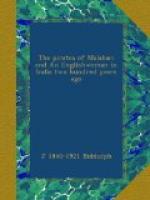On reaching Carpenter’s Bay in Mauritius, he found an impudent message from the pirates, ’writ on Captain Carpenter’s tomb with a piece of charcoal,’ to the effect that they had been expecting him and had gone to Port Dauphin. The squadron next proceeded to Bourbon, where they sold some casks of arrack and madeira to the French for a very good profit, and thence proceeded to Charnock Point, St. Mary’s Island, Madagascar. Here they found the wrecks of several merchant ships that had been run ashore by the pirates. Scattered on the beach were lying their cargoes, china ware, rich drugs and spices, cloth, guns, and other articles, lying where the pirates had cast them. Men waded knee-deep in pepper, cloves, and cinnamon, such was the quantity. In shallow water were lying the remains of a fine Jeddah ship that had been taken, with thirteen lakhs of treasure on board, by a pirate named Conden, who commanded a ship called the Flying Dragon. Matthews at once began to transfer the guns and such commodities as were least damaged to his own ships. A flag of truce had been first sent ashore to communicate with England and the other pirates, but it was found that they had fled inland. A week later, a white man, accompanied by a well-armed guard of natives, made his appearance. He told them that he was a Jamaica man named John Plantain, that he had been a pirate, but was tired of the trade, and had settled down on the spot. This John Plantain was a man of some note in the piratical world. Every and England had sailed with him, and treated him with much consideration and some fear. He had made himself master of a considerable tract of country, so that the pirates had given him the name of the King of Ranter Bay.[4] He gave an invitation to Matthews to visit his castle, where he entertained some of the officers of the squadron. Matthews’ first idea was to seize him, but finding that John Plantain had a good number of armed natives with him, besides a Scotchman and a Dane, and that his castle had plenty of guns mounted, he decided to trade with him instead. The pirates made no secret of having taken part in the capture of the Goa Viceroy’s ship, and of a rich native vessel with eighteen lakhs of rupees on board. So hats, shoes, stockings, wine, and arrack were made over to John Plantain, for which he paid a good price in gold and diamonds. In spite of his notions as to piracy, John Plantain showed himself an honester man than Matthews. Having paid liberally for the things he had bought, he left the hogsheads of wine and arrack on the beach under




